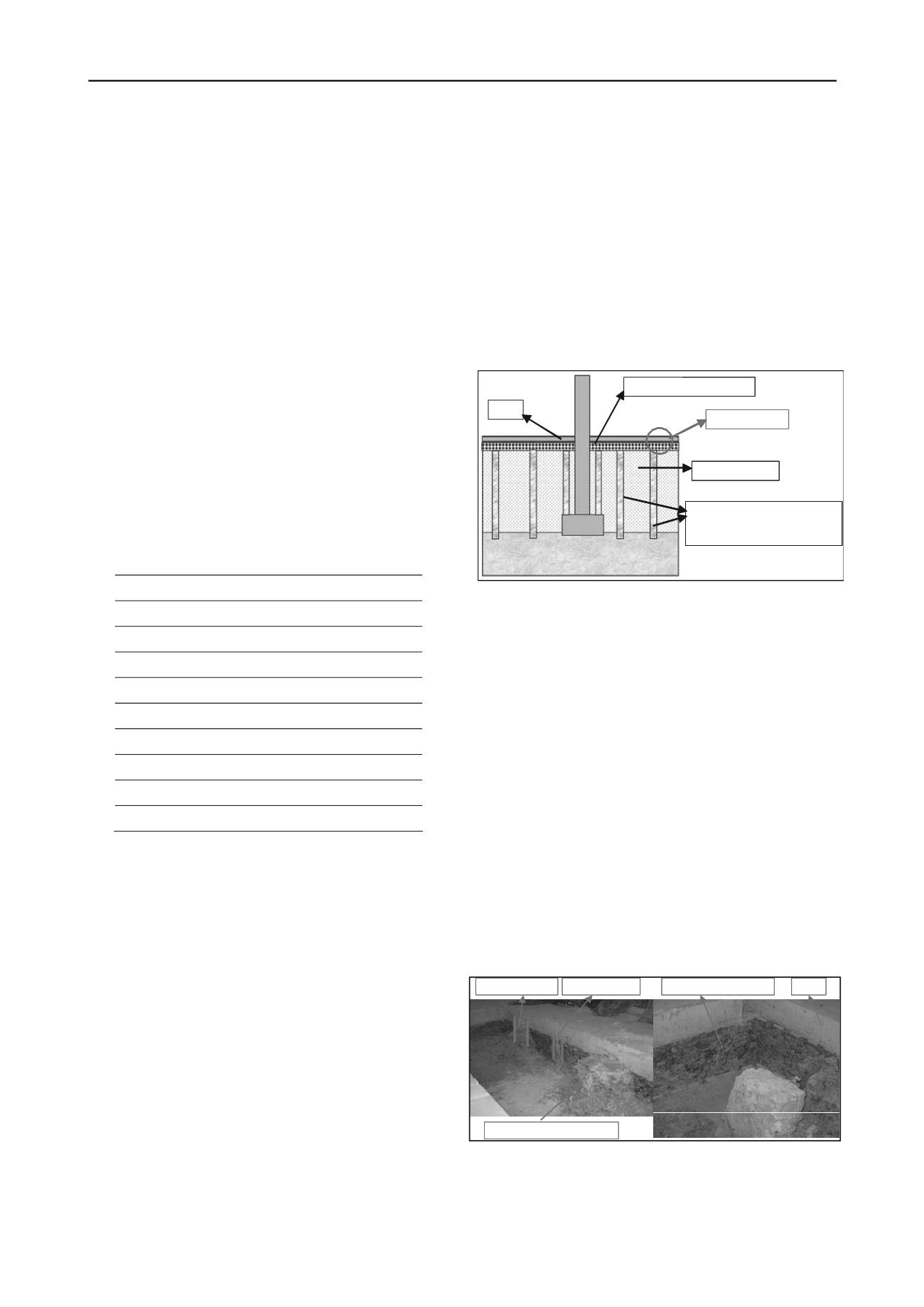
2550
Proceedings of the 18
th
International Conference on Soil Mechanics and Geotechnical Engineering, Paris 2013
diameter along the column depth. figure 1 shows the nowadays
available original and modified improved springsol
tool. the
folded tool is of a diameter of 150 and 165 mm for the original
and modified version respectively.
some of the advantages of the method are:
-
no pollution of the subgrade layer with the cement
slurry, due to insertion of the casing that enables the
recovery of spoil.
-
the spoil collection with the system installed at the
base of the mast of the drilling rig, connected to the
peristaltic pump drawing the spoil directly to the
container.
-
the high production rate.
-
Working under difficult execution conditions and
limitations, i.e. under low headroom conditions and
within reduced spaces.
-
execution with small batching plants and small drilling
rigs in reduced limited spaces, etc.
the quality of soil-cement columns regarding their
homogeneity and strength is influenced by two parameters:
-
im (rev/m) - blade rotation number determining the
mixing efficiency defined as a total number of mixing
blades passing along one meter of tool penetration, and
-
ii (kg/m
3
) - cement quantity introduced per m
3
of the
treated soil.
table 1. springsol
columns performance and geo-mechnaical
arameters.
p
parameter
diameter (mm)
400-700
Water / cement ratio
0.6-1.2
penetration velocity (cm/min)
15-50
im (rev/m)
min 350
ii (kg/m
3
)
150-350
Ucs (mpa)
0.5-6.0
e
50
(50-500) Ucs
shear strength
20-40% Ucs
Bending strength
8-15% Ucs
the general execution parameters and geo-mechanical
characteristics (unconfined compressive strength - Ucs,
stiffness modulus – e
50
, shear and bending strength) of the soil-
cement columns executed by the springsol
device are given in
table 1. these data are established on experiences gained on
different projects and field tests carried out recently in spain
(melentijevic et al 2012, melentijevic et al 2013). these
findings on geo-material properties are in agreement with
worldwide published information on deep mixed columns
(Bruce 2001, cdit 2002, etc.).
3 proJect details and adopted GroUnd
improVement solUtion
in this chapter an example of application of the springsol
technique for underpinning is presented. the industrial building
in the central spain presented different post-constructive
pathologies regarding differential settlements of floor slabs and
pavements as a consequence of poorly compacted anthropic fill
material. the main structure (walls and columns) were founded
on a natural ground, and due to its adequate geotechnical
characteristics did not present any pathology. the shallow
foundation on a natural ground was performed after a massive
excavation of superficial layers of natural soil, applying the
same material for construction of a fill without its appropriate
compaction.
the affected area included more than 8000 m
2
with the
installation of more than 2500 soil-cement columns. the length
of soil-cement columns ranged from 5.50 m to 8.00 m in
function of the thickness of the man-made fill, with the total
length of columns of more than 15000 meters. due to the form
of the springsol
tool, the columns were embedded
approximately 20 cm in the natural ground. the columns of a
400 mm diameter, performed with the originally developed tool,
were distributed in a square grid pattern ranging from 1.50 m to
2.00 m in function of the surcharge to be transmitted from the
slab. the performed solution is schematically presented in
figure 2.
Slab
Springsol columns Ø400mm
Length = 5.50–8.00m
Grid=1.50x1.50m 2.00x2.00m
Man made fill
Natural soil-clays with
gravel and boulders
Grouting gap slab-fill
figure 2. cross section of the ground treatment solution.
the post pathology site investigation consisted of 46
dynamic penetration tests and 5 drilled boreholes with standard
penetration tests, executed from the working platform, i.e. the
existing floor slab level. the natural ground, detected at the
depth of 5.50 to 8.00 m from the surface, consisted of clays of
high consistency with gravels and boulders, with the n
20
>40
(dpsh). the overlaying treated loose man made fill was
formed of clays with gravels (n
20
<10) proceeding from the
natural ground after a massive excavation for the foundation of
the main structure elements.
the soil treatment solution included following steps:
-
coring of the existing slab (diameter = 62 mm) for
grouting of the gap between slabs and fill.
-
contact grouting between the slab and the fill in order
to fill gaps due to settlement of badly compacted man
made fill.
-
coring of the existing slab and contact grouted gap
(diameter = 182 mm) for the passage of the spreadable
tool.
-
execution of springsol
columns (diameter = 400 mm).
-
filing the gaps of coring the existing slab.
Visual description of the executed steps previously
mentioned is shown in figure 3.
figure 3. Visual control of the excavated treatment area.
see Figure 3
Slab
Grouting gap slab-fill
Coring 62 mm
Coring 182 mm
Springsol columns 400 mm


